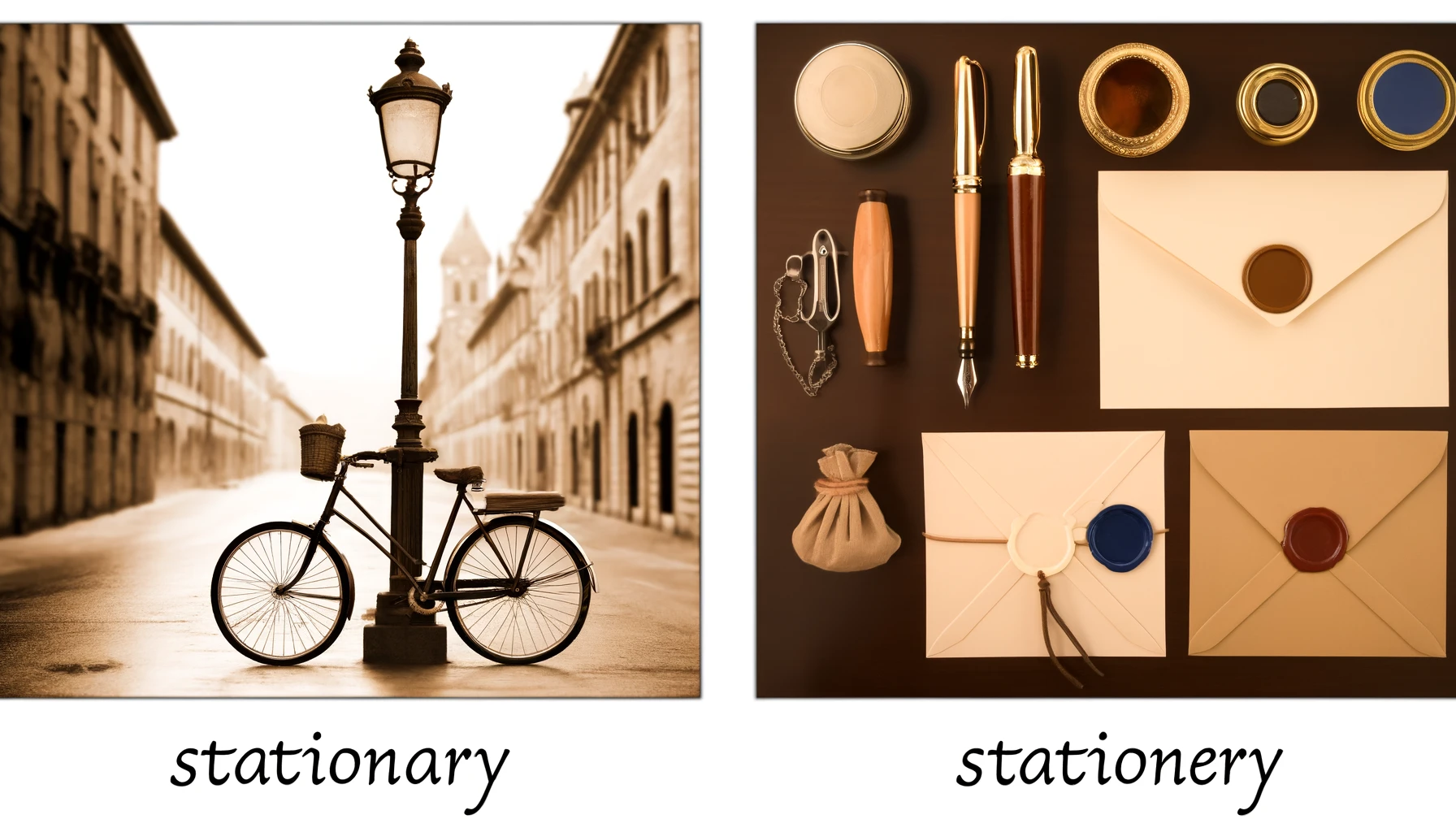
Editly Etymology: stationary vs stationery
The experts at Editly have become masters of commonly confused words over the course of their careers as editors, proofreaders, and humanizers. In Editly Etymology, they reach deep into their experience to provide a closer look into the horrifying beauty of the English language. This installment investigates a classic of vocabulary vexation: stationary vs stationery.
Stationary Definition
Stationary is an adjective that means not moving.
Stationery Definition
Stationery is a noun that means writing paper.
Did you catch that? Just to make sure, let’s ask AI to help us generate a visual representation of each of the words.
Stationary = not moving.

Stationary = not moving.

Interestingly, this stationery does not appear to be entirely stationary.
Stationary Root
Late Middle English, from Latin.
Stationery Root
Middle English, from Latin.
Who is to Blame for this Confusion?
While Latin bears initial responsibility, English is truly to blame for the twisting and turning and craziness that has led “stationary” and “stationery” to be so easily mistaken for one another.
AI Text on Stationary
The word "stationary" has an etymology that traces back through the Latin language, reflecting its meaning related to being fixed or not moving. Here’s a detailed exploration of its history:
- Latin Origins: "Stationary" comes from the Latin word "stationarius," meaning fixed or established. This term is derived from "statio," which means a standing or a post. "Statio" itself stems from "stare," which means to stand. The sense of standing or staying in one place is central to the meaning of "stationary."
- Medieval Latin and Old French Influence: In Medieval Latin, "stationarius" was used to describe booksellers who had fixed positions or stalls, as opposed to itinerant traders. The term passed into Middle English from the Old French derivative "stationnaire."
- Middle English Usage: By the Middle English period, "stationary" was used in English to describe something that was fixed in one place, unchanging, or immobile. It applied to positions or objects that were meant to remain in a certain place.
- Modern Usage: Today, "stationary" retains the meaning of being immobile or not moving. It is commonly used to describe objects that are meant to stay in one place, such as stationary bikes (exercise bikes that do not move from their spot) or stationary supplies like paper and pens, which are typically used at a desk or fixed location.
- Clarification and Usage Note: It is often confused with "stationery," a similar-sounding word with a completely different meaning, referring to materials used for writing, such as paper and office supplies. "Stationery" comes from the same root due to the fixed location of stationers who sold books and paper in the past.
The history of "stationary" illustrates how the word has maintained a consistent meaning related to immobility and fixedness from its Latin origins to modern English usage, emphasizing the continuity and stability of certain concepts in language despite the evolving nature of vocabulary. (315 words)
Humanization of AI Text on Stationary
"Stationary" has an etymology that traces back through the Latin language. Here’s a detailed exploration of its history:
- Latin Origins: "Stationary" comes from the Latin word "stationarius," meaning fixed or established. This term is derived from "statio," meaning a standing or a post. "Statio" itself stems from "stare" (to stand).
- Medieval Latin and Old French Influence: In Medieval Latin, "stationarius" was used to describe booksellers who had fixed positions or stalls. The term passed into Middle English from the Old French derivative "stationnaire."
- Middle English Usage: By this period, "stationary" described something that was fixed in one place or unchanging. It applied to both positions and objects.
- Modern Usage: "Stationary" retains the meaning of being immobile or not moving. It is commonly used to describe objects that are meant to stay in one place, such as stationary bikes or stationary supplies.
- Clarification and Usage Note: It is often confused with "stationery," a similar-sounding word with a completely different meaning, referring to materials used for writing, such as paper and office supplies.
The history of "stationary" illustrates how the word has maintained a consistent meaning, emphasizing the continuity and stability of certain concepts in language despite the evolving nature of vocabulary. (205 words)
Result of Changing the AI Text to Human Text
Converting the AI content to human content has vastly improved its flow, readability, and utility. One of the primary indicators of this change is length, which has been reduced from 315 words down to 205 words—or nearly 35%—without losing any of its original meaning.
AI Text on Stationery
The word "stationery" has an interesting history that connects it to the same root as "stationary," but with a specific development related to trade and materials for writing. Here's how "stationery" evolved:
- Latin Origins: Both "stationery" and "stationary" derive from the Latin word "stationarius," meaning standing still or set in place. This Latin term is rooted in "statio," from "stare," which means to stand.
- Medieval Latin Usage: In Medieval Latin, "stationarius" began to refer specifically to traders or sellers who had fixed selling places or shops, as opposed to itinerant merchants. Over time, this came to be associated particularly with sellers of books and related materials.
- Middle English Development: The term entered Middle English as "stationer," referring to a bookseller or a vendor of written material. By extension, "stationery" came to denote the products sold by stationers, which included paper, writing implements, and other materials for writing and office use.
- Modern Usage: Today, "stationery" refers specifically to materials used for writing, paper, envelopes, pens, and other office supplies. The word is commonly used to describe the high-quality paper goods and writing materials sold in shops or used in business settings.
- Separation from "Stationary": Although "stationery" and "stationary" share a common origin, their meanings have diverged significantly. "Stationary" retains the sense related to being fixed or immobile, while "stationery" has developed a trade-specific meaning related to writing materials. This differentiation highlights how words can evolve specific meanings related to cultural and commercial practices.
The history of "stationery" illustrates the influence of trade and commerce on language, showing how specific professions can shape the meanings of words over time. This connection between language and material culture provides insights into the social and economic histories embedded within everyday vocabulary. (291 words)
Humanization of AI Text on Stationery
"Stationery" has an interesting history that connects it to the same root as "stationary," but with a specific development related to trade and materials for writing. Here's how "stationery" evolved:
- Latin Origins: "Stationery" also derives from the Latin word "stationarius," meaning standing still or set in place. This Latin term is rooted in "statio," from "stare," meaning to stand.
- Medieval Latin Usage: "Stationarius" began to refer specifically to traders or sellers who had fixed selling places or shops. Over time, this came to be associated particularly with sellers of books and related materials.
- Middle English Development: The term entered Middle English as "stationer," referring to booksellers or vendors of written material. By extension, "stationery" came to denote their products, including paper and writing materials.
- Modern Usage: "Stationery" refers specifically to materials used for writing, paper, envelopes, pens, and other office supplies—especially high-quality paper goods and writing materials.
- Separation from "Stationary": Although "stationery" and "stationary" share a common origin, their meanings have diverged significantly. "Stationary" retains the sense of being fixed or immobile, while "stationery" has developed a trade-specific meaning related to writing materials.
The history of "stationery" illustrates the influence of trade and commerce on language and everyday vocabulary, showing how specific professions can shape the meanings of words over time. (217 words)
Effect of Humanizing the AI Text
Humanization has significantly improved the AI content, making it clearer and impactful through better diction and the insistent elimination of repetition. This type of concision can be measured mathematically, as humanization has reduced the word count from 291 words to 217 words—or by more than 25 percent.
The Takeaway
Whether it’s for stationary or stationery the best AI humanizer does, in fact, turn out to be a human. So, if you need any help to humanize your AI text, don’t wait to get started on Editly.


Paul S.
Online editing, proofreading, and rewriting for both human and AI text. Specialties include admissions essays, academics, business, blogs, and ChatGPT to human text. Chief editor at Editly AI.